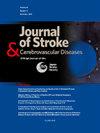一例罕见的双侧基底动脉网
IF 1.8
4区 医学
Q3 NEUROSCIENCES
Journal of Stroke & Cerebrovascular Diseases
Pub Date : 2025-07-06
DOI:10.1016/j.jstrokecerebrovasdis.2025.108393
引用次数: 0
摘要
背景:基底动脉网是一种罕见且未被充分认识的血管异常,可能导致后循环缺血性卒中。在有限的报道中,基底动脉网在基底动脉的不同位置表现为薄的膜状腔内缺陷。51岁男性,左上肢不自主运动10天,伴有长期记忆减退和步态不稳定。他没有中风或心血管疾病史。头部非对比ct显示无出血,实验室检查不能诊断。飞行时间磁共振血管造影显示基底动脉远端严重局灶性狭窄。高分辨率黑血磁共振成像和数字减影血管造影发现了两个明显的、薄的、光滑的膜状腔内缺陷,与基底动脉网一致。这是第一例在基底动脉同一段内同时存在两个网状病变的报道。虽然没有观察到明确的梗死,但血管异常可能损害穿支动脉流动或破坏局部血流动力学,可能导致局灶性脑干缺血。结论本病例拓展了目前对基底动脉网的认识,强调了高分辨率血管壁成像的诊断价值。识别这种罕见的异常对于准确的卒中风险评估和个性化的预防策略非常重要,特别是对于没有传统血管危险因素的患者。本文章由计算机程序翻译,如有差异,请以英文原文为准。
A rare case of bilateral basilar artery webs
Background
Basilar artery web is a rare and under-recognized vascular anomaly that may contribute to posterior circulation ischemic stroke. In limited reports, basilar artery webs have appeared as thin, membrane-like intraluminal defects at various locations along the basilar artery.
Case Presentation
A 51-year-old man presented with a 10-day history of involuntary movements in the left upper limb, along with longstanding memory decline and gait instability. He had no history of stroke or cardiovascular disease. Non-contrast computed tomography of the head showed no hemorrhage, and laboratory investigations were not diagnostic. Time-of-flight magnetic resonance angiography revealed severe focal stenosis in the distal basilar artery. High-resolution black-blood magnetic resonance imaging and digital subtraction angiography identified two distinct, thin, smooth, membrane-like intraluminal defects, consistent with basilar artery webs.
Discussion
This is the first reported case of two coexisting web-like lesions within the same segment of the basilar artery. Although no definitive infarction was observed, the vascular anomalies may have impaired perforator artery flow or disrupted local hemodynamics, potentially contributing to focal brainstem ischemia.
Conclusion
This case expands the current understanding of basilar artery webs and emphasizes the diagnostic value of high-resolution vessel wall imaging. Recognition of this rare anomaly is important for accurate stroke risk assessment and individualized prevention strategies, especially in patients without conventional vascular risk factors.
求助全文
通过发布文献求助,成功后即可免费获取论文全文。
去求助
来源期刊

Journal of Stroke & Cerebrovascular Diseases
Medicine-Surgery
CiteScore
5.00
自引率
4.00%
发文量
583
审稿时长
62 days
期刊介绍:
The Journal of Stroke & Cerebrovascular Diseases publishes original papers on basic and clinical science related to the fields of stroke and cerebrovascular diseases. The Journal also features review articles, controversies, methods and technical notes, selected case reports and other original articles of special nature. Its editorial mission is to focus on prevention and repair of cerebrovascular disease. Clinical papers emphasize medical and surgical aspects of stroke, clinical trials and design, epidemiology, stroke care delivery systems and outcomes, imaging sciences and rehabilitation of stroke. The Journal will be of special interest to specialists involved in caring for patients with cerebrovascular disease, including neurologists, neurosurgeons and cardiologists.
 求助内容:
求助内容: 应助结果提醒方式:
应助结果提醒方式:


